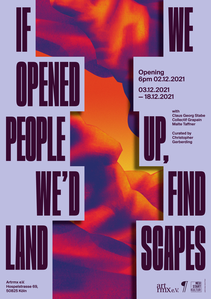Projekte: 2021
If we opened people up, we'd find landscapes
The sacred in a faulty printer
Some centuries ago, although not that many, the reality of an ordinary person was that of being in two places at once. The pre-industrial individual lived the reality of their life of work, as well as the reality of their belief in an active exchange with the divine. Here is an exhibition about how our lived reality has, in much the same way, crossed over with the digital. While they are not quite on a mystical quest, in the work of Collectif Grapain, Claus Georg Stabe, and Malte Taffner, we find a particular sensitivity for process. Brought together here are positions that contemplate what it takes to arrive somewhere in this world between the body and the machine, and what at times can go wrong along the way.
This meditation on the fallible is most explicit in the work of Claus Georg Stabe, where intricate penwork accumulates line after line into the illusion of a faulty machine photocopying memories of the sublime. Stabe’s dense Moiré effects, interrupted by ink drips, seem to contend with the desire to escape from form, into an expression of devotion to the trace that perception leaves on inner experience.1
Devotion in Stabe’s work is also to honour the shadow of the memory, to know how much infrastructure is necessary to begin to express the act of perception. Similarly Collectif Grapain seek to establish monuments for the hidden mess of the sleek contemporary. Instead of allowing the slowly obsolete ethernet cable to clog up another landfill, feeding the earth with microplastics, the artists compose contorted agglomerations of these cables into almost organic sculptural forms. This act suggests both a tribute to Moore’s law2 as well as a warning shot. If we opened people up we would find the dreams of previous generations in the shape of the metal remains of the balls of all their computer mice.
If we opened people up, we‘d find landscapes posits the possibility of an act of transparency, a baring: Instead of perceiving landscapes of desire at a distance,3 we can or perhaps even already do embody them.4 It is not in your head, but in your hands: make it happen. In this show by the curator Christopher Gerberding we find the dichotomy between verifiable knowledge and its application re-articulated in the disquieting way in which we have come to encounter it with unspeakable regularity throughout the pandemic.5 We cannot know what would happen if we opened people up, as they would be dead, and so no longer people. We can only trust in the potential of this poetic assertion, backed up by the work of Collectif Grapain, Claus Georg Stabe, and Malte Taffner. We cannot cure our doubt through edict, people would just see that as a challenge. Things are unpredictable, thumbs are opposable, the macro view varies appreciably from the microcosm. Each individual is a high-wire act, balancing between their privilege and the all consuming perfectionism of a data driven society. I think therefore I am. I know therefore I am confused. Oh God...6
Of the three artists in this show, Malte Taffner seems the least interested in what a landscape could come to mean, and looks rather at what a landscape actually is. Taffner’s work engineers natural processes and seeks to put them in relation to the planned zones of metaphorical thinking that make up the sites of the artworld. In this way his and Gerberding’s entreaties meet as complementary forces, whereby Taffner suggests that if people had the time to find landscapes, maybe they would open up.
Krzysztof Honowski, November 2021
1 See Jack Goldstein’s pursuit of the trace in his lecture at the Art Center College of Design, Pasadena, California, October 14, 1992
2 A 1965 observation by Intel’s Gordon Moore which accounts for why technology just keeps getting better and better.
3 pace the Ecstatic Landscapes of Werner Herzog
4 And one quickly comes to the relieving realisation that Christopher Gerberding is also suggesting that you cannot shell a human like a walnut without being a psychopath.
5 And who are we anyway? The people? The polis? The audience in collusion with curator? Here “we” allows us to perceive a togetherness, or a directness that we have only newly come to appreciate through it’s pandemic-induced denial.
6 Or perhaps “The word God”, which is the devotional authority that preoccupies Georges Bataille.
